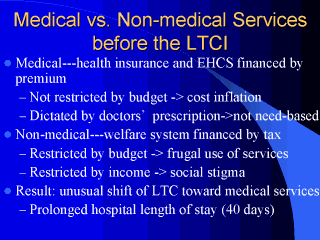| front |1 |2 |3 |4 |5 |6 |7 |8 |9 |10 |11 |12 |13 |14 |15 |16 |17 |18 |19 |20 |21 |22 |23 |24 |25 |26 |27 |28 |29 |30 |31 |32 |33 |34 |35 |36 |review |
 |
The benefit of the EHCS
is similar to health insurance and does not include non-medical services such as home help
and nursing home. Such non-medical services have traditionally been financed by welfare
system whose benefit is subject to budget restrictions and whose eligibility is rationed
considering the recipients' financial conditions. Japan's LTCI system was created to solve both problems. This is chiefly the reason why Japan's LTCI integrates not only non-medical welfare services but also medical services such as visiting nursing and geriatric hospitals. This is a crucial difference from German LTCI, which covers only non-medical services. Simply put, Japan's LTCI is a total restructuring measure with more advanced and sophisticated features not seen in the existing system. |